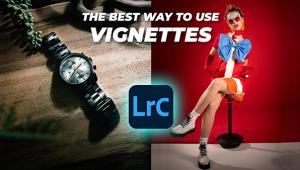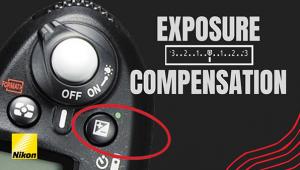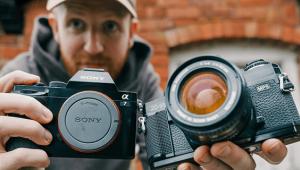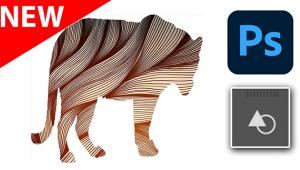Pro's Choice; Chris Vincent’s Liquid Realities; Capturing Pours, Spills, And Splashes Page 2
Taking Control
Each one of these takes is not simply spilled milk, to lap up a metaphor. While Vincent notes that very little has changed in the physical execution of the pours since he started shooting them with analog capture technology, the compositing process has been made more efficient and cost-effective in the digital age. In Photoshop, Vincent brings together various bits and pieces from different shots and combines them into a final composite to produce the required effect. In essence, you make order out of seeming chaos. It usually involves at least three or four elements to a splash shot. And as before, it is left to the client to retouch the final image.
Kellogg’s Corn Pops |
|
 |
|
|
Taking control of the situation may involve one or more assistants working in tandem. Timing is everything. Contributing to that are the tools involved, which give Vincent tighter control over these spills and pours. For less demanding shots he may simply pour the liquid manually. But very often a client requires a precise effect and that often translates into specialized hardware. For splashes he turns to an electromechanical rig, which he rents from Hugo Cimmelli (www.cimmellisfx.com). This device is designed to drop an object from a fixed height and in exactly the same manner.
Another key component in all this is the Toolbox control system from the Kapture Group, which he rents from Foto Care (www.fotocare.com) in New York City. The system consists of a laser (not infrared) trigger, which is eminently suited to high-speed captures under bright lights. An integral part of this system is the delay unit. Vincent explains: “Imagine dropping an ice cube into a glass of scotch. The laser is positioned maybe 2 inches above the glass; the ice cube falls and interrupts the laser beam, which would then trigger the camera and strobes to fire. But if the camera/strobe is tripped at that instant, the ice cube will be seen as hovering above the glass. The delay mechanism gives it time to actually fall into the glass, make contact with the liquid, and create the spatter. That delay need be no longer than a few hundredths of a second.”
Of course, none of this would be possible without his Broncolor Grafit studio strobe system. These lights are designed to output tightly controlled, ultra-short flash bursts. Vincent has used flash durations down to 1⁄6000 sec, although he may set them slightly longer—at 1⁄4000—to allow more of a natural flow of liquid.
Crown Royal Splash |
|
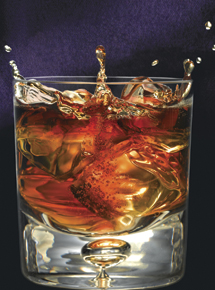 |
|
|
A Few Tricks Of The Trade
The factors that govern the intensity of a splash are the height from which an object is being dropped, velocity and direction of descent, mass, rotational direction and speed, and surface texture of the object, as well as the viscosity of the liquid. The problem, as Vincent discovered, is that when you drop a spherical object such as a marble into a glass of water, for example, you achieve a token splash because the marble has a minimal effect on breaking the surface tension of the liquid. To create more of a splatter, that marble needs a bumpy texture, which he achieves by adding dabs of glue at various spots on the marble’s surface.
Now, what do you do with that marble once it’s in the shot? You can retouch it out entirely. But when the marble represents fruit or an ice cube, it is replaced by a shot of a piece of fruit or an ice cube that is composited into the picture.
And when it comes to ice cubes, they’re always acrylic, which Vincent gets from Trengove Studios
(www.trengovestudios.com). Trengove also makes tanks that Vincent uses on some of these jobs.
Black (& White) |
|
 |
|
|
Keeping things in a tank is one way to control a splash, but that’s rarely suitable to his general methodology. Vincent takes a more practical approach to keeping liquids from making a mess. “We cover lots of stuff with plastic, including the assistants sometimes,” he adds with a chuckle. “Unless you’re doing something really big, it doesn’t splash around a whole lot. You sometimes have to put a sheet of clear glass in front of the lens/camera for protection. And sometimes you position the tumbler on a large tray, which serves as a catch basin.” Other than that, you just put down drop cloths to cover up the floor.
“I’ve used plastic kiddie pools underneath a set when necessary to collect the liquid.”
It’s all in a day’s work, although, truth be told, these projects often extend for several days, from designing the set to final execution. And after the job is completed to everyone’s satisfaction, Vincent reflects: “I still feel that same sense of excitement I felt when I created my first splash.”
- Log in or register to post comments





































